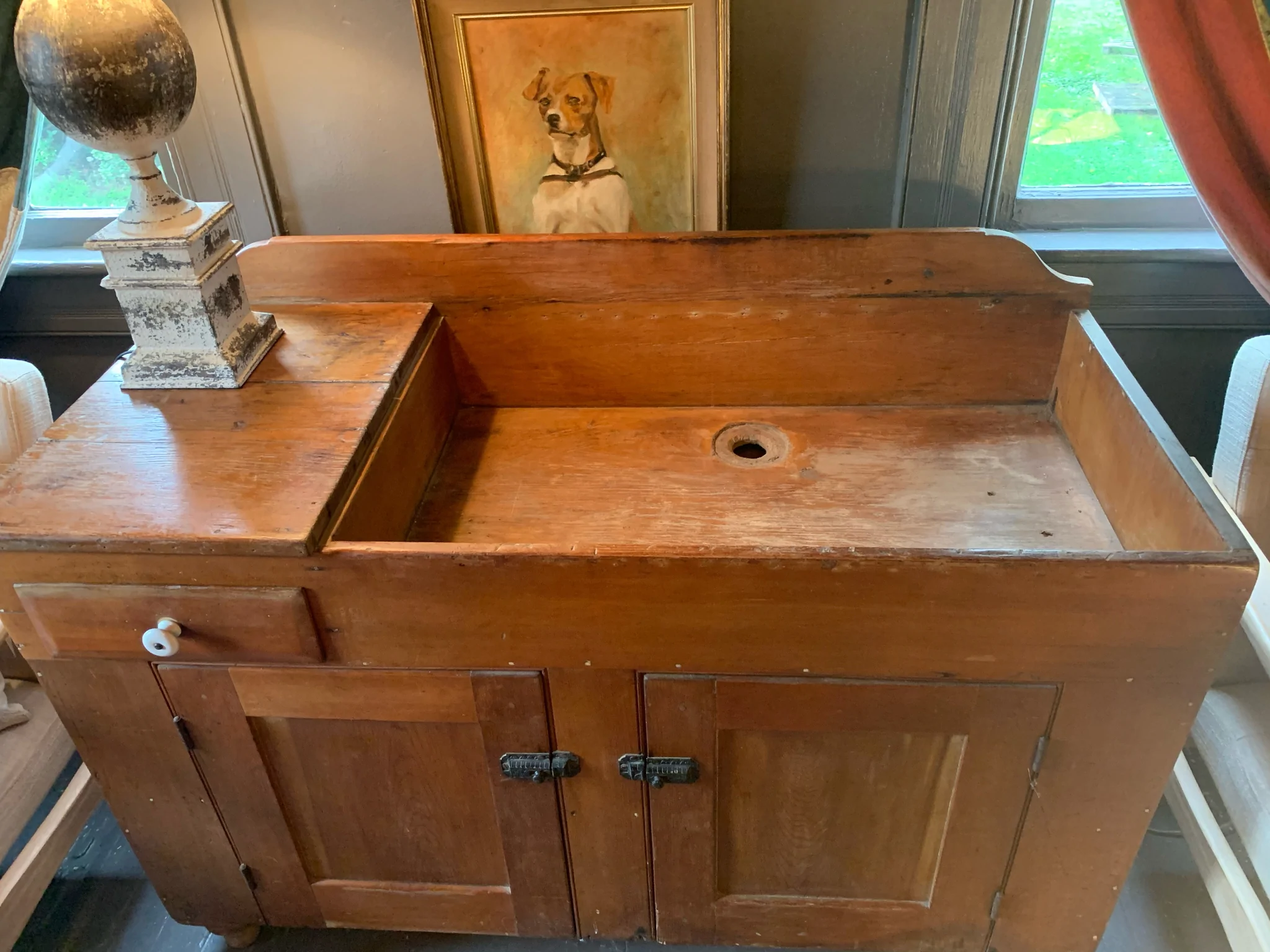Have you heard of antique dry sinks but aren’t sure what they are? On the other hand, you might already have one and are wondering what it’s all about. You’re in the right place!
Antique dry sinks were used throughout the 19th century and partly in the 20th century. They offered a place to put your water pitcher, use a wash basin, hang your towel, and store other items. Nowadays, antique dry sinks are used decoratively or as collector’s items across the United States and the world.
Table of Contents
What Is an Antique Dry Sink?
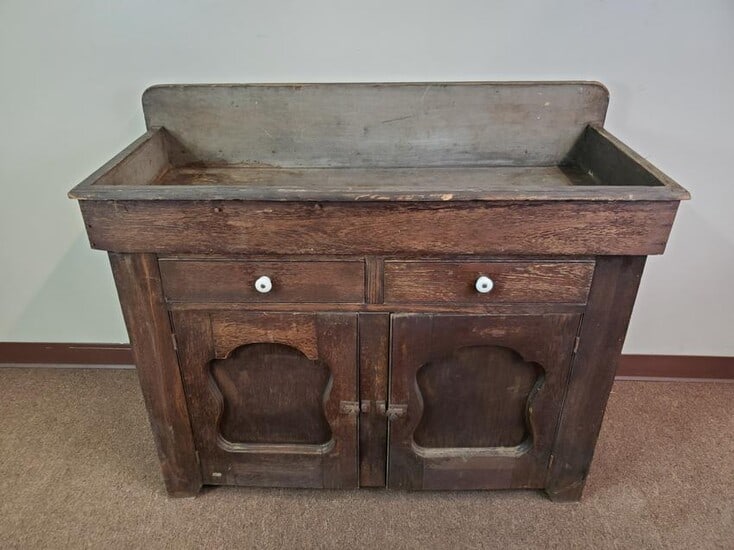
The name dry sink is an oxymoron in itself and it can be misleading. These pieces of furniture were used to hold wash basins for kitchens, bathrooms, and even on farm porches. They do not have a sink installed within them, which is why they are called dry pieces of furniture.
In the 19th century, vintage dry sinks were a staple in most American homes. Since homes were not connected to indoor plumbing, families had to collect water and bring it inside for things like washing and cleaning.
The water was then put into a basin, which is similar to a bowl. Once the water was used, it was thrown away and the basin was refilled from the pitcher.
Indoor plumbing began to develop in the U.S. in the 1840s. By the early 20th century less than half of U.S. homes had a bathtub or shower, hot water, and a flush toilet. By the mid-20th century, outhouses and dry sinks began to become a thing of the past as indoor plumbing became more accessible for all.
Some under-developed countries continue to use alternative designs of dry sinks around the world today.
What Were Dry Sinks Used For?
Many antique dry sinks have a recessed top which was used to catch any water spilled by the pitcher or basin. The recessed area placement might have been to the left, right, or centered. Non-recessed dry sinks were also used, especially during the Victorian era.
The water in the basin might have been used to wash fruits and vegetables, hands and faces, or to clean up a kitchen or bathroom area.
These sinks also had storage space, like a dry sink cabinet, to put away things like towels, toiletries, or kitchen items.
Nowadays, especially in the U.S., almost everyone enjoys running water and a built-in sink. Nevertheless, dry sinks have been repurposed as antique decorations. They’re even used as furniture pieces, with the sink area holding things like trinkets, jewelry, or stationary. Some are even used as nightstands or as additional kitchen counter space.
What Do Dry Sinks Look Like?
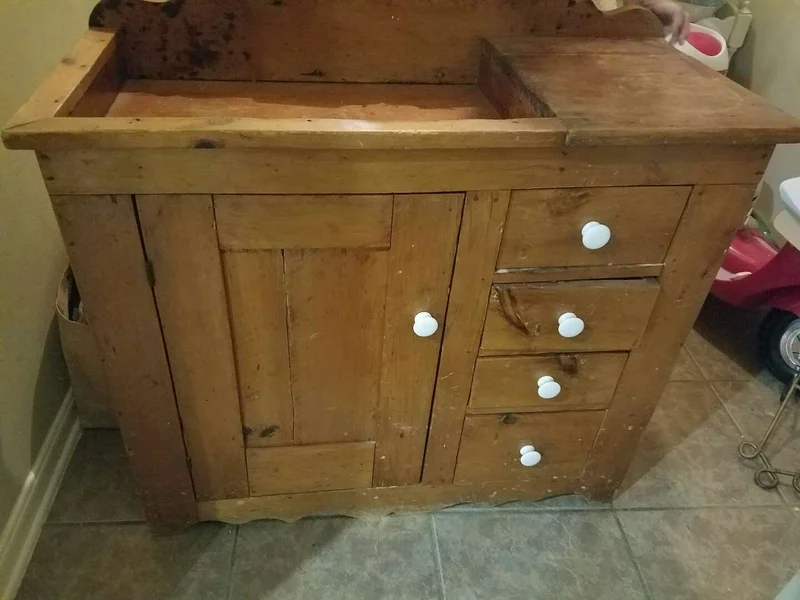
Antique dry sinks resemble small modern wardrobes or even larger modern nightstands. They are usually around 40 inches high and vary in length and width depending on the model.
Virtually all dry sinks are made of wood, with the vast majority made of pine.
More expensive dry sinks in upper-class homes may have been made of other wood materials. They also incorporated decorative tops, such as those made of marble. Higher-end vintage dry sinks had the tops lined with waterproof materials, like copper, to avoid rotting the wooden base.
Dry sinks tend to have storage space below the washing area. These include a few drawers or cabinets of different sizes. Hooks may also have been placed within the drawers or on the outside of the dry sink to hang up wet towels.
It’s important to differentiate between an antique dry sink and an antique washstand.
Washstands are smaller, have flat tops, and always have an added backsplash area. Washstands hold just one shelf for the basin and pitcher. Some have one drawer below, but the storage space is limited compared to a dry sink.
Early Manufacturers of the Dry Sink
Unlike other antique pieces, most antique dry sinks were handmade by furniture makers or carpenters. There are no big-name dry sink companies, so it’s hard to pinpoint the origin of many pieces, especially those from the 19th century.
One company that built dry sinks in the early to mid-20th century is Ethan Allen.
Identifying a True Antique Dry Sink
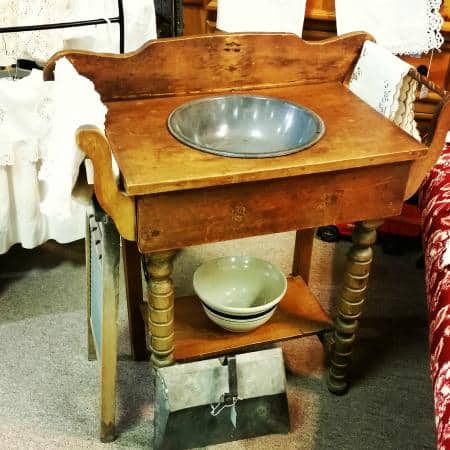
Unfortunately, modern companies and even individuals sometimes try to create false antique dry sinks for sale. Without solid manufacturer marks, it’s easy to get swindled and purchase a replica for the cost of an original.
Some ways you can determine that a dry sink is truly an antique and not just a replica are by identifying the wood, observing the wear and tear, analyzing the carving, and checking out the dovetail joints.
1. Identify the Wood
The first thing to do is make sure that your antique piece is made of solid wood. Most antique pieces will be made with thick wooden pieces, as they were handmade and built to last.
Look for growth rings as a dead giveaway that your piece is made of solid wood. If you see any large, repeating patterns, this might be a wooden veneer instead, which means the piece is machine-made.
As we mentioned, antique pine is the most common type of wood for antique dry sinks. You may also find vintage dry sinks made of birch, maple, walnut, mahogany, oak, or cherry woods.
2. Observe Wear and Tear
If your dry sink is truly vintage, you’ll observe some signs of use from over the years.
This is often seen in the form of small scratches, worn-out areas, seam separation, water stains, or through the patina. Patina is a green or brown film you may find on any metal on the dry sink, such as on corroded hardware. This is produced by oxidation over time.
Another dead giveaway to a fake antique is if it still smells like the wood it’s made from. After about a century, you can be sure your antique dry sink will smell musty, like mildew, or not at all.
Some fake antiques will use recycled wood to appear old, so don’t rely simply on its appearance to determine that the piece is antique.
3. Analyze the Carving
If you have a true antique from the 19th century, your dry sink may have some hand carving on the drawers, panel doors, or backsplash. Hand carvings will be uneven and unsymmetrical. If you see a perfectly carved, smooth detail in your dry sink, it was likely done by a machine in more modern times.
Another trick is to look at the end of any visible boards within the sink. There should be swirls in the cuts to indicate that the wood was cut with a circular saw.
If you see any putt-filled nail holes or areas that seem stained over, this may be a sign of reclaimed wood and a fake vintage dry sink.
4. Check Out the Dovetail Joints
Dovetail joints are a series of cuts on two pieces of wood that allow them to fit into one another, joining them. Think of it like two puzzle pieces fitting together.
Wooden furniture both young and old uses dovetail joints, but an antique’s joints will be irregular. There will also likely be three, instead of four or five. Perfectly aligning dovetail joints are a sign of machine construction.
Other signs of a fake antique dry sink are staples, new screws or nails, or any fiberboard.
How to Date an Antique Dry Sink
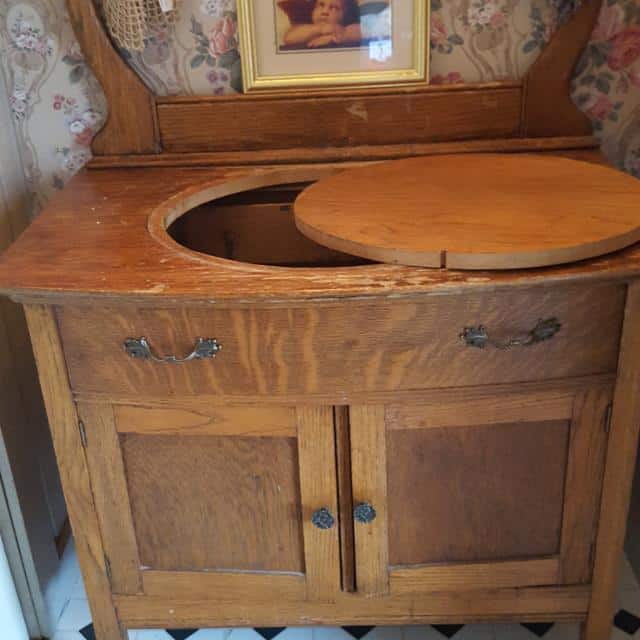
Dating an antique dry sink is no easy task – especially without things like manufacturing stamps or logos from that time.
To try and date your antique dry sink, first look at the details. Simple woodwork, primitive style, and very limitedly decorated dry sinks are likely from the late 19th century. Painted cabinets or a more farmhouse style would suggest they’re from the mid-20th century.
Maker’s marks are also a way to identify when it was made, although many antique dry sinks will lack these because they were handcrafted.
Finally, take note of the quality. Hardwood, solid antique dry sinks were built to last. They are high-quality antiques, with thick pieces of material and sturdy craftsmanship. Newer pieces will be thinner, flimsier, and generally not as durable.
How Much is an Antique Dry Sink Worth?
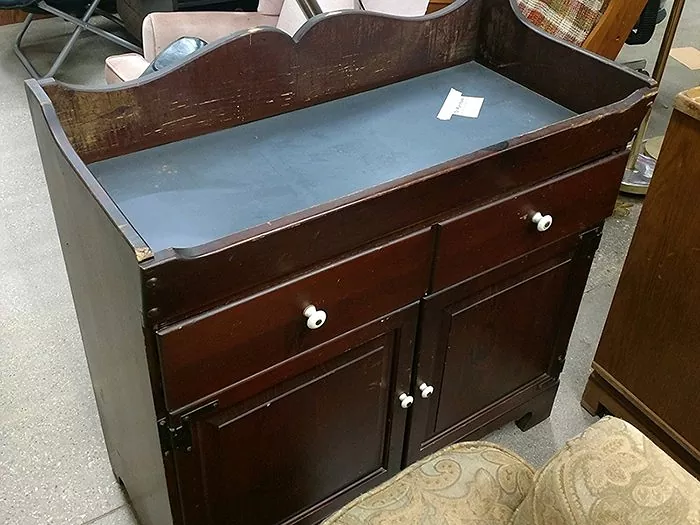
An antique dry sink could be one of the best purchases you make if you value the sink correctly and repurpose it in your own home. Most antique dry sinks in good condition can be bought for around $200 to $300, although a great piece could cost more than $1,000.
The price of an antique dry sink will be affected by:
- The craftsmanship
- Any damage
- If it’s been painted
- Its age
Generally speaking, the better the craftsmanship, the less damage it has, and the older it is, the more it is worth. Painting any antique will decrease its value, although some simple repairs or restoration could increase its worth.
The cheapest antique dry sinks can be found for around $100. These are weather-beaten, scuffed, and worn. You might find big cracks, scratches, or even a missing door cabinet on this one.
A nicer antique dry sink will cost a couple or a few hundred dollars. These may be a similar age as the cheaper dry sink, but restored or kept with care. The better the restoration, the higher the price tag.
Now and again, you’ll run into a dry sink in superb condition that costs upwards of $1,000. These may have their original finish in excellent condition, are usually dated fairly accurately, and should have been professionally appraised.
How to Renovate an Antique Dry Sink
There are many ways to renovate your antique dry sink, giving it a new purpose and place in your home. You decide whether you want to restore it to its original glory or revamp it into a more modern-looking antique.
Before completing any of these steps, be sure to wear the appropriate gear such as gloves and protective eyewear.
Clean It
You can’t start your renovation until you clean your antique from top to bottom. Take a damp rag and pass it over all of the surfaces of your dry sink, including the inside and sides of any drawers or cabinets.
If there are any sticky spots or residues, add a mild soap to your water mixture, dampen your rag again, and pass it over the area. Avoid using any strong chemical products in this step.
Fix Scruffs and Scratches
If your antique is full of scruffs and scratches, you may want to get rid of them for its new look. There are a few options for this step:
- Cabinet and furniture restorer can be bought at your local supermarket or home improvement store. This will fill small scratches while also adding some shine to the piece.
- Wood filler is a good option for deep cuts or gouges in your piece. The filler will also accept different stains so it will blend right into your piece if you plan to paint or re-stain it.
- Scratch cover is a liquid that works great on lighter scuff marks.
- An Epoxy wood repair stick is great for large cuts and gouges. Most repair stick material can be sanded, drilled, or even tapped after drying.
Refinish Stained Areas
If your antique has water stains or other stains that aren’t coming out, you may have to refinish the piece. This is also a good option for those who want to restore their antique to its original hardwood glow.
First, take out any removable parts, like drawers or cabinet doors.
Next, scrub your antique with steel wool dipped in a paint stripper. You can also apply the thinner with a brush and use the wool later for removal.
As per the paint stripper’s instructions, let it sit, and then wipe down your piece with mineral spirits or water. Let the antique dry for a day.
Then, sand your antique to remove any unsightly remnants. Apply a wood conditioner, sand it again, and finally apply your stain. Be sure to brush the stain along the grain.
Follow your paint’s curing instructions. After it’s cured, paint a second coat and leave it to dry for one day.
Finally, add a sealant to your antique dry sink and enjoy its new look.
For a video of a similar process, watch the following.
Paint Your Dry Sink
If you want to make a big change, consider painting your dry sink a bright color, like blue or white, to create a more modern look. Do note that painting an antique will diminish its value, so avoid this step if you plan to sell the piece later on.
Chalk paint will give your sink a textured look, while lacquer can give your antique a facelift without making it seem like a different piece.
Add Cabinet Liners
If you’d rather keep its wooden look but want to make it more fun, you can spice things up by adding some removable drawer and shelf liners to your sink. Choose the pattern or color of your choice.
You could also change out any hardware to match or give it extra flair.
Repurpose Your Dry Sink
Finally, find a new purpose for your dry sink. It can be used as a nightstand, tabletop, kitchen counter space, TV stand, wet bar, display case, or vanity.
Some people may also use it as an entryway piece to place things like handbags, keys, or a mirror when you’re on the go.
Others have even converted dry sinks to hold plants in sunrooms or covered patio spaces.
Where to Buy an Antique Dry Sink
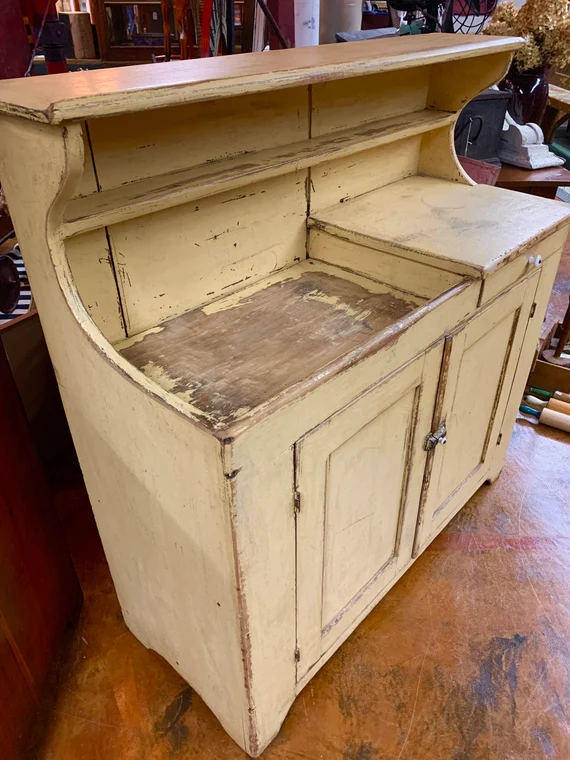
Antique dry sinks are fairly easy to buy at antique shops and online. Buyer beware: be sure to properly investigate your piece before shelling out hundreds of dollars for it.
- A local or online antique shop or auction is your best bet when it comes to finding an authentic dry sink at a reasonable price. These vendors will have price comparisons and experiences with other dry sink sellers and clients. You should find a knowledgeable salesman or woman there who could answer any of your questions before making your purchase.
- Flea markets and second-hand furniture stores are great places to search for antique dry sinks. Since these treasures can be mistaken for any old piece of furniture, you could get lucky and snag one at a great price.
- A home for all types of items, eBay is another great online resource to find ads for all sorts of antiques. Just make sure to verify its authenticity and compare prices before paying a hefty price for any antique. Some sellers even offer free shipping.
- Etsy is another online marketplace that may offer a variety of dry sinks. Just as with any online source, be sure to research what you’re buying before making your offer.
- Facebook Marketplace may also sell some antique dry sinks now and again. Many offers will require local pickup. Craigslist is another option.
While plenty of other states offer vintage dry sinks for sale, Pennsylvania is one of the largest vendors of this type of antique. With the large Amish population known for their sturdy craftsmanship, it’s no wonder PA is one of the top places for antique shopping.
Conclusion
Antique dry sinks were once a kitchen or bathroom staple, but they are now a collector’s item that can add personality to any home. These antiques can be used as nightstands, for decorative purposes, as extra kitchen countertop space, and more.
Dating an antique dry sink isn’t easy, but be sure to look out for solid pinewood pieces that are made to last. If you’re looking to buy one yourself, check out antique shops, second-hand furniture stores, flea markets, eBay, Etsy, and Facebook Marketplace.
When you have your dry sink, be sure to display it somewhere all your guests can see. Everyone will be sure to appreciate the craftsmanship and décor of your antique dry sink!
